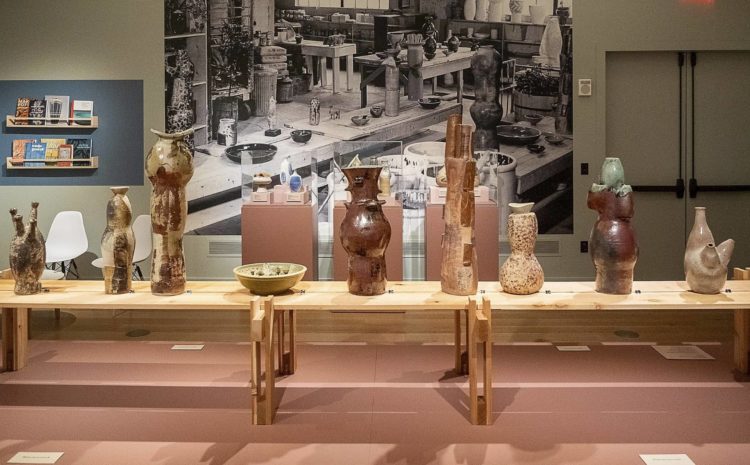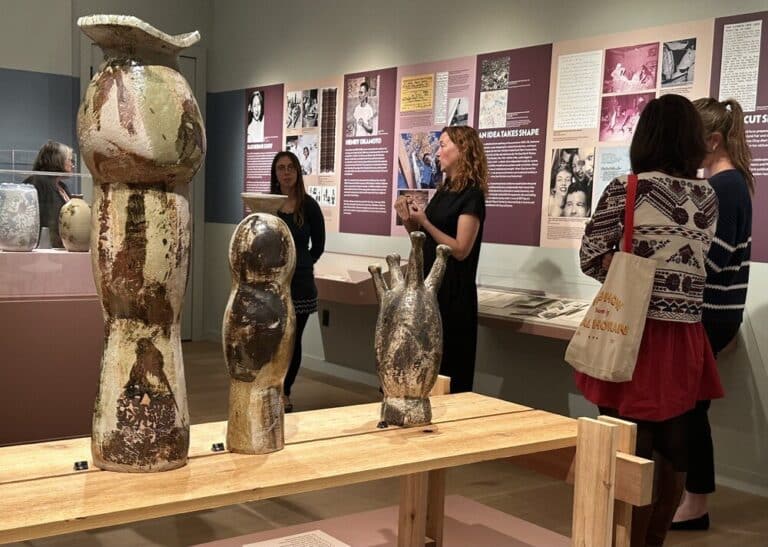Greenwich Sentinel | November 14 | By Liz Leamy
In October, the Greenwich Historical Society debuted its latest exhibit, ‘Radical Pots & Cooperative Hands: Katherine Choy and Clay Art Center’ that celebrates the life and legacy of Katherine Choy, the trailblazing 20th century ceramic artist and visionary co-founder of the renowned Clay Art Center in Port Chester, New York.
This remarkable exhibit, which is slated to run through early February, is a stunning visual and informational examination of Katherine Choy and her esteemed co-founder Henry Okamoto who formed the iconic Clay Art Center in 1957.
“This exhibit is conceived to capture the sense of discover, excitement, creativity and collegiality of these artists right in our own backyard,” said Maggie Dimock, Curator of Exhibitions and Collections at the Greenwich Historical Society.
By all means, this exhibit tells the story of Choy as well as that of Okamoto and the history of Clay Art Center in a truly profound and fascinating manner.
It features a vast amount of information, archival documents and photographs and other materials explaining the fascinating history, background and impact that Choy, Okamoto and this vial movement had upon the regional and national art and cultural community from their start together up through to the present in amazing detail.
“The vision, commitment and talent of Katherine Choy and Henry Okamoto formed the inspiration for this exhibition. Choy’s ceramic work was notable for its innovative approach, exploring the boundary between craft and fine art,” said Dimock. “Her work and her legacy are nationally important, but we wanted to tell her story and Okamoto’s through the lens of local history. They and the other ceramic artist who formed Clay Art Center lieved in our community and were plugged into exciting movements in the world of studio ceramics that defined the field for years to come.”
Certainly, this exhibition is a transportive experience in itself.
Notably, it features an extensive showcase of ceramic art pieces created by Choy and Okamoto, as well as dozens of photos with background information about these transformative artists and their community which is enlightening, fascinating and immersive, particularly with the huge full-wall black and white photo of the Clay Art Center studio situated on a wall that makes one feel as if they are actually there during this exciting time in art history.
“For the Greenwich Historical Society, it was exciting to work with Clay Art Center to share the story of an influential artist like Choy whose influence in the ceramic art world was significant, but whose local legacy is less well known, even if many in our community may be familiar with Clay Art Center,” said Dimock. “Choy’s legacy is extensive and profound. She, Okamoto and other notable ceramic artists like Viola Frey, who was an early part of Clay Art Center before she returned to California to embark on her own successful artistic career, all contributed to the increasing interest in ceramic art, which continues today, nearly 70 years later.”
Visitors are being impacted by this exhibit, that is for certain.
“As a relative neophyte to the ceramic arts, I was drawn to the exhibit because of its connection to local artisans,” said Barbara Ormerod-Glynn, former Director of the Greenwich Library who had recently visited the exhibit. “The photographs, documents and selected ceramic pieces offer a timeline to the evolution of Choy’s talent while Curator Maggie Dimock offers a lively and thoroughly engaging explanation of the historical importance of the works.”
“Before going to the show, I really didn’t know all that much about Katherine Choy other than she was one of the founders of the Clay Art Center,” said Jeannine Madoff. “She was remarkable not only for her artistic talents and vision, but for the sheer courage it took for a female artist in her day to up and leave a secure position at Newcomb College and travel hundreds of miles north to Port Chester to build a studio from the ground up and focus on her own art. It’s also amazing that in doing so, she provided a place for other potters to work and collaborate with each other.”
The fascinating life and history of Choy, meanwhile, explains so much as to why she has made such an impact with so many through her art over the decades.
Born in Hong Kong in 1927 and then raised in Shanghai, Choy traveled to the U.S. in 1946 in order to study at Wesleyan College in Macon, Georgia.
A few years later, Choy moved to Oakland, California to study at Mills College where she earned a Bachelor of Arts degree in 1950 and Master’s degree in 1951, respectively.
In 1952, she began working at Newcomb College at Tulane University in New Orleans as the head of the ceramics department.
Several years after that, Choy moved to the New York metropolitan area, where she then went on to co-found Clay Art Center with Okamoto as a communal studio dedicated to the advancement and practice of ceramic art.
“Her history, background, talent and knowledge lay the groundwork for Clay Art Center’s impact on the arts over the years,” said Dimock. “She was so dedicated and committed to making space for herself and other ceramic artists to produce their work.”

Choy, whose work is featured at the Metropolitan Museum of Art, Museum of Arts and Design, Newark Museum of Art and the New Orleans Museum of Art, had sadly passed in 1958, just a year after she and Okamoto had started Clay Art Center.
Upon Choy’s passing, Okamoto proceeded to put his heart and soul into continuing Choy’s vision, building Clay Art Center into a haven and working home base where ceramic artists, many of whom went on to become game changers in the art world, could work and develop their talents. Okamoto remained the Director of Clay Art Center until his passing in 1988.
“Katherine Choy was a visionary who, through her partnership with Henry Okamoto, helped create this ceramic community. It’s an incredible story and represents a real coming together of artists,” said Dimock. “This was a transformative time, as Clay Art Center went on to become one of the most noteworthy centers for ceramic art in not just this region, but in the United States. People’s lives were changed.”
Today, the legacy of Choy and Okamoto remains as strong as ever with the art world and Clay Art Center, a non-profit organization that is one of the largest and busiest ceramic facilities in the New York metro area serving more than 25,000 people through exhibitions, classes, workshops and volunteer opportunities.
Moreover, the generosity of Clay Art Center in regard to helping make this exhibit happen through the Greenwich Historical Society has been palpable and speaks so much about both of these organizations’ incredible dedication, passion and commitment to helping bring as much information about the art world to the community as possible.
“We wouldn’t have been able to do this exhibit without the partnership of Clay Art Center, who has been just so generous and involved every step of the way,” said Dimock.
These sentiments were echoed by others as well.
Certainly, in considering how both factions play such a paramount role in the art world and New York metropolitan area communities through their dedication to enriching, educating and inspiring individuals through their programs, exhibits such as this one show their impact, that is for sure.
For everyone involved with this exhibit, this is what it’s all about.
“The function of creativity is important in life and the story this exhibit tells is important. It represents a profound extension of the themes of Greenwich Historical Society explores through our interpretation of the legacy of the Cos Cob colony of American Impressionism, the first Impressionist art colony in Connecticut which was based here at the Bush-Holley House,” said Dianne Niklaus, Historical Society Director of Marketing and Communications. “The most beautiful part of this story of Clay Art Center is the perseverance and passion of these amazing artists, and we want to support that idea in every way possible through this exhibit.”


